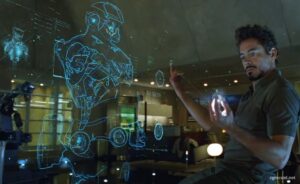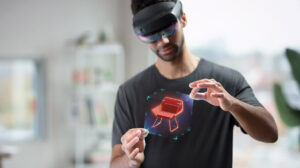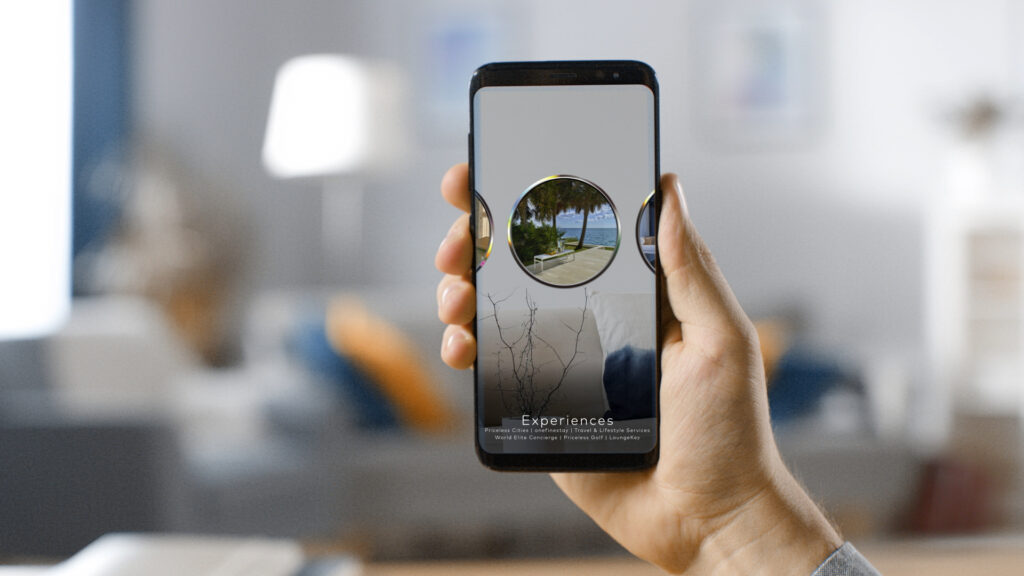Augmented Reality

Augmented reality (AR) is one of the pop-up trends and sales strategies within marketing and it provides brands and real-world experiences for their customers. Modern technologies anchorage the actual strength of augmented reality and build their digital marketing strategy captures high income through enlarged business opportunities and sales. According to Garter’s IT Glossary – “AR is real-time information in text, graphics, audio, and virtual enhancement integrated with real-world.
Technologies Of Augmented Reality
- Head-up displays (HUD)
- Holographic displays
- Computer
- Microsoft’s HoloLens
- Contact lenses
Head-Up Displays (HUD)

Heads-up- display (HUD) is a crystal clear display that presents data without vital users precluded from their usual viewpoints. A classic HUD includes three primary components: a projector unit, a combiner, and a video generation computer. The projection unit in a usual HUD is an optical collimator setup: a convex lens or concave mirror with a cathode-ray tube, light-releasing diode display, or liquid crystal display at its focus. Head-up displays were a forerunner technology to augmented reality, incorporating a subspace of the features essential for the full AR experience, but beings short of the essential registration and tracking between the virtual content and the user’s real-world environment.
Holographic Displays

A holographic display is a kind of 3D display. Holographic displays can utilize light diffraction to display a three-dimensional image to the viewer. Holographic displays do not require the viewer to wear any special glasses or use external equipment to be able to see the image and do not cause the vergence accommodation conflict.
Types of holographic displays are:
Touchable holograms
Touchable holograms were originally a Japanese creation that became further enlarged by the American microprocessor company Intel. Touchable hologram technology is the recent modern representation of the holographic displays that one might see in sci-fi movies such as Star Wars and basically in the Star Trek television franchise.
Laser plasma
The laser plasma display was introduced in 2005 by the University of Texas and is capable to portray very bright and visible objects, but it lacks respect resolution and picture quality. Micromagnetic piston display.
Piston display
The Piston display launched by Belgian company IMEC in 2011, utilizes a MEMS (micro-electro-mechanical system) predicated structure. In this type of display, thousands of microscopic pistons are able to be operated up and down to act as pixels, which in turn reflect light with appetited wavelength to constitute an image.
Holographic television display
The holographic television display was founded by MIT researcher Michael Bove in 2013. he created a Microsoft Kinect camera as an approximately productive way to capture subjects in a three-dimensional space. The image is then refined by a PC graphics card and replicated with a series of laser diodes. The created image is fully 3-dimensional and can be viewed from all 360 degrees to gain a dimensional perspective.
Computer

The computer inspects the sensed visual and other data to integrate and position augmentations. Computers are in charge of the graphics that go with augmented reality. Augmented reality uses a computer-generated image which has a conspicuous effect on the way the real world is shown. With the development of technology and computers, augmented reality is going to lead to an extreme change in one’s outlook on the real world. It displays by overlaying the images with valid computer-generated data.
Microsoft’s Hololens

Microsoft hololens is an AR headset developed and manufactured by Microsoft. The hololens is a first-generation AR device. It also plays an important role in mixed reality (MR). The HoloLens is a head-mounted display unit related to an adjustable, cushioned inner headband, which can slope HoloLens up and down, as well as forward and backward. Using head-related transfer functions, the HoloLens bring about binaural audio, which can affect spatial effects; the user can virtually recognize and locate a sound, as though it is coming from a virtual pinpoint or location.
Contact Lenses

Contact lenses are thin lenses placed directly on the surface of the eyes. Contact lenses are the type of glasses that display information on the world around us so we can see both the online and real world at once. It displays AR imaging that is in development.
Current Examples of AR Technology:
IKEA Mobile App: Shoppers commonly use this app to arrange how tables and shelves would look in different places around the house.
Nintendo’s Pokémon Go App: Pokémon Go invented users to catch their favorite Pokémon by looking through their phones in the real world – but with superimposed images
Google Pixel’s Star Wars Stickers: Google added an advantage to the camera of its Pixel phones that implemented users to input AR stickers into pictures and videos.
Leveraging Augmented Reality in digital marketing strategy:
Modern businesses are leveraging the power of augmented reality (AR) and creating their digital marketing strategy more captivating for higher revenues and expanded business opportunities and sales. AR establishes marketers with the capability to transform a static object, such as a printed advertisement or magazine cover into an enveloping 3D experience. Mobile has become one of the most significant media types through which consumers can communicate with brands and make purchase decisions. AR gives businesses another tool in their belt when it comes to driving sales and enlarging brand value through mobile devices.
How does the metaverse important in augmented reality?
Augmented reality is essential in the metaverse. The use of AR in Metaverse is prepared for the Augmented Metaverse which aims to unbolt the invisible potential of virtual ecosystems. Technology can modify our core society in a great way leaving us with the best of technological wonders. Experts recommend that by 2024 the world might see the initial fully operable AR glasses enlarged by top-tier manufacturing firms. This will boost market penetration as AR will be used to increase access to critical layers of information.
Metaverse firms use Augmented Reality to enrapture the attention of customers by permitting them to enjoy the spectacular vision of the physical and digital world. This also helps to improve physical engagement with digital tools, making the users customary to new technologies. The technology helps creators to use online and offline infrastructure for making potent projects. The 3D content built by experts for digital spaces can be pervaded in Metaverse and AR ecosystems to help operate substantial value from the project.
Use Case: Museums
Museums can utilize AR Technology to make speculation about their upcoming exhibitions. Interestingly, visitors can use the app or AR headset inner the museum to history and see how the dinosaurs and objects visualized in the exhibition looked about thousands of years ago. This is indeed a great way to increase tourism and academic experience as technology implements people to involve with the objects on a deeper level.
Use Case: IKEA
The Sweden-based furniture retail company has currently restored its traditional photography with 3D renderings. The digital catalogs and IKEA app let users see how a piece of furniture of an apt color and size would look in their homes.
Use Case: Warby Parker
The direct-to-consumer eyeglass brand, Warby Parker, launched a ‘virtual try-on’ system that lets its customers try glasses in the comfort of their homes. Users just want to download the app, choose the style of the frame they need to try, and then activate the feature that opens up the front camera and places the glasses on their faces. The glasses stay fitted in their place even if the person moves and leans their head.
Use Case: Travel Industry
The global hospitality and tourism industry can attract and engage customers through interactive AR elements added to their digital advertisements. AR is the ability to expand the customer base of hotels, booking services, local restaurants, and all other stakeholders in the industry.
Conclusion
AR-based travel apps quickly involve customers with their interactivity and render an enveloping user experience. The importance of augmented reality in digital marketing can’t be stressed enough. The potential of AR is infinite to the point that it can help brands unravel completely new business opportunities. It shows real, tangible solutions to help drive sales and make marketing innovations. this also helps forward-looking retailers and brands offer consumers customized experiences for future growth.
|
ReplyForward
|

